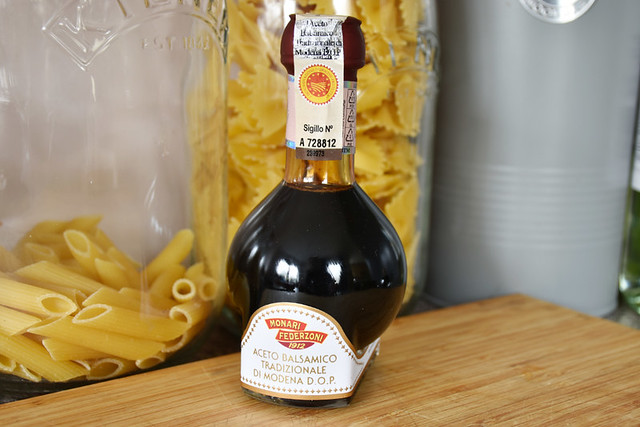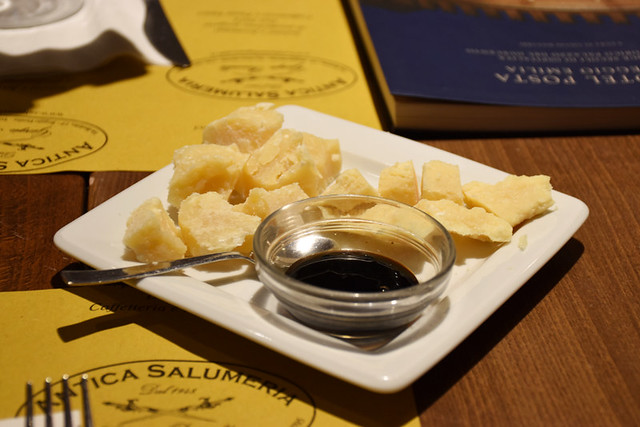My attention was caught by a post on Facebook where a travel writer/blogger wrote they’d had an argument with a vineyard owner because they’d tried to pawn them off with a balsamic vinegar from Modena which wasn’t authentic. They posted a photo of the ‘fake’ bottle alongside the ‘real thing.’ The thing is, both bottles were actually authentic. So, how did the experienced travel writer get it wrong? Here’s the explanation, with tips on how to identify authentic balsamic vinegar from Modena.
The first thing you need to know is there’s a hierarchy when it comes to balsamic vinegars. Top of the tree is…
Aceto Balsamico Tradizionale di Modena
This is the real deal, the black gold of Emilia Romagna, the region of Italy where Modena is located. This is the stuff to make the bottles in your local supermarket cower in embarrassment at their reedy impersonations. In Emilia Romagna it’s used on everything, by the people who can afford to drizzle it about generously, from adding a sharp sweet punch to Parmigiano Reggiano (Parmesan cheese) and elevating vanilla ice cream into the gelato stratosphere (so long as it is used sparingly) to performing the role of a digestif at the end of a meal.
Aceto Balsamico Tradizionale di Modena must be made in a very specific way to earn its coveted title. For a start, it can only be made in Modena. That might sound obvious, given its name, but just because a product has a geographic locator in its name doesn’t mean it comes from there – think Mars bar. Better still, don’t, that’s a nonsense example. Brussels sprouts works better, but you get the point. Made from the must of certain grapes which is crushed and cooked in open-air boilers, Balsamico Tradizionale is aged for a minimum of twelve years until it has a syrupy consistency and a delicious intensity.
But how can you identify it? It’s quite simple. Aceto Balsamico Tradizionale di Modena must be sold in 100ml bottles designed to represent the shape of a drop of the liquid inside – the bottle is a thing of beauty designed by car maker Giorgetto Giugiaro. Aceto Balsamico Tradizionale di Modena isn’t cheap. We bought a bottle direct from a family who made it for €40, but it can set you back a lot more, especially the 25-year-old stuff.
There is another, very simple way to identify it. I’ll get to that in a bit.
The other authentic balsamic vinegar
To add a drizzle of confusion into the mix, there is another authentic ‘traditional’ balsamic vinegar that isn’t as well known. It’s called Aceto Balsamico Tradizionale di Reggio Emilia. Produced by the neighbouring town of Reggio Emilia, whose residents claim it is better than Modena’s, Aceto Balsamico Tradizionale di Reggio Emilia is produced in much the same way as its rival and is also sold in 100ml bottles. However, Reggio Emilia’s are tulip shaped. Is it as good or even better? We tried some in Antica Salumeria Giorgio Pancaldi, on chunks of Parmigiano and accompanied by light and fizzy Spergola wine. All I know is my palate isn’t sophisticated enough to tell the difference.
How to identify the fake that isn’t a fake
At the bottom of Modena’s balsamic vinegar tree is Aceto Balsamico di Modena. It is balsamic vinegar, and it is from Modena, so deserving of its title despite the assertions of the travel writer referenced at the start. It isn’t, however, of the same quality and, as a result, must be classed as a condimento. So, while the travel writer wasn’t correct, neither was she completely wrong. What makes it different from Aceto Balsamico Tradizionale is that wine vinegar, aged for at least ten years, is added following fermentation. Once this blend has aged for three years it qualifies to be labelled as Aceto Balsamico di Modena. This is the balsamic we find in most supermarkets in the UK, and it is still wonderful when drizzled on cheese, added to stews and pasta dishes, and used to make a salad dressing. It’s just not as good as the Tradizionale. But it is a hell of a lot cheaper, so better suited for more liberal use in the kitchen. And, as you can see from the picture above, just because it’s not Tradizionale doesn’t mean it can’t come in a sexy wee bottle.
The really easy way to tell the difference
Bottle shapes aside, the at-a-glance way to spot whether a balsamic vinegar is a Tradizionale or a condimento lies in the labelling. Authentic Aceto Balsamico Tradizionale di Modena must have DOP on the label. This indicates Denominazione d’Origine Protetta (Protected Designation of Origin in English) and shows that there is a unique link to the place where it was produced and that every part of the process takes place within that area. Aceto Balsamico di Modena, on the other hand, should display IGP on the label. This signifies Indicazione Geografica Protetta (Protected geographical indication in English) showing there is a geographical connection between the product and the area it is linked with, and that part of the production process must take place in that area. If a balsamic vinegar has neither, walk on by, it could have been made down the road.








Be the first to comment